Feridun Oral, who is both the author and illustrator of the book, Different but the Same tells the story of a yeanling that was “born a little different than others in the herd” from birth to her motherhood.
Feridun Oral, who is both the author and illustrator of the book, Different but the Same tells the story of a yeanling that was “born a little different than others in the herd” from birth to her motherhood. The story begins with a shepherd carrying the newborn yeanling to the barn when he realizes “the weakness of her legs”. “Forelegs of the yeanling are paralyzed” and it is “impossible for her to walk like this”. Thus, the narrator begins the story by drawing attention to that we should be aware of the discrepancy. In this respect, the disabled protagonist of the story is important to help children develop their empathy skills. Therefore, with these types of reading practices, “the child, who has never seen a disabled person before, encounters with disability through a children’s literature book and develops an inclusive view rather than an exclusive view.” (Gürdal 44)
In Turkish children’s literature books disability has been often expressed as “handicapped” (özürlü) and “crippled” (sakat). Latest works made on this subject emphasize that the word “disabled” should be used instead of them. On the other hand, there are some authors who use the term “exceptional children” instead of disabled. These authors dwell on illustrating these “exceptional children” as “multidimensional characters”. In their stories, they emphasis on avoiding from “showing these disabled children as heroes” and “giving the reader feeling of that these children need pity and understanding” (Gürdal 51). At this point, the usage of language has a particular importance in order to develop empathy skills. By the reason of, “positive language usage makes a positive effect on the perception of self” (Gürdal 135). In fact, in the Different but the Same, the narrator creates a positive impact on both same and different readers, who are children, by using the word “different”. But is only this impact enough?
Ayfer Gürdal Ünal, in her Disability in Turkish Children Literature (1969-2009) emphasizes that the heart of the story should be concentrated on the disabled character in a good disability story and the expression type, which can reflect the character’s inner world in the best way, can help the purpose of the work. Therefore, in a literary work covering this topic, the narration which can reflect the character’s inner world in the best way has to be “a disabled self-narrative” (111). However, in Feridun Oral’s aforementioned work, a non-speaking character confronts the reader as the main character. At this point, the disabled character being a yeanling -when it is considered with Piaget’s ideas on animatism phase in child development- can be a facilitating factor for the child reader to empathize with the character.[1]
Moreover, emotional transition of the narrator should be in the story. In this case, the narration technique of the Different but the Same is a good example. That is to say, in this story, even though the shepherd immediately grabs the yeanling, which was born different than others, the yeanling consistently cries until they reach the barn. After that day the shepherd “carries him in his saddlebag”. On the other side, other yeanlings “quickly grow up” and play around in the pasture. The yeanling in the shepherd’s saddlebag joins this game “pretending to be a goat”. His friends laugh at his imitation not him and “they have fun together”. But of course, the mood is not always cheerful. Sometimes, the shepherd plays his pipe and the little yeanling gets sad and dreams about “running at mountains and hills and playing with his friends.” Shepherd cannot be indifferent to this situation anymore. One day, when all members of the herd were on pasture, “he draws something on the ground while looking at the little yeanling” and he thinks. First, “he cuts a few branches from the nut tree on the side”, then braids them looking like a basket.
“The next morning while the rest of the herd is asleep, shepherd grabs the little yeanling and takes him to the yard”. What he made is a “different kind of bicycle”[2]. Shepherd puts the little yeanling on the bicycle and pushes him a little.
The yeanling surprises at first, he can’t know what to do for a while. Then, he slowly starts riding this bicycle while “giving his weight to the front” and “can stand on his hind legs.” Now he “baas happily”. He baas so loud that rest of the herd wakes up. He runs to his mother. At this part of story’s illustration, rest of the herd just watches him with smiley faces. At this point, it is an important detail of the story that, the only reaction rest of the herd gives to this development is to “wake up because of the loud voice”. Because in this narration, rest of the herd approaches to the different bicycle of the different yeanling as if it is an ordinary thing. After all, “from that day on, the yeanling climbs to mountains with the herd,” and moreover “he humps newly born yeanlings and walks around”. In this way, the yeanling is portrayed as a character consisting many feelings such as sadness, joy, worry, and thrill and even loving a goat at the end of the story. After a while, the little yeanling becomes a “teen goat” and the “the shepherd makes a bigger bicycle for him”. This detail is also crucial because it saves the author from becoming one of Ayfer Gürdal’s eight character types in her thesis.
According to the research by Ellen Rubin and Emily Watson, there are “various cliché disabled types in literary works” and these types can be categorized with eight different titles (quoting Gürdal 46). The sixth of these types is “the disabled who feels pity for himself as the biggest enemy of himself”[3]. In stories with this type, “the disabled is illustrated as someone who can immediately be involved in life if he/she can get rid of feeling pity for himself.” However, there are obstructions coming from the social structure which prevent the real acceptance by society, such as in communicational and architectural cases. The discourse saying that disabled person can be involved in life if he/she can free himself/herself from these negative feelings is a discourse which was developed without considering obstructions coming from the social structure.” (46-47).
At first sight, the approach of the shepherd to the main character in Different but The Same is similar to this discourse, however, the location of the story and making a bigger bicycle when the yeanling grows up do not allow this similarity. Because the location is a rural area and the main character does not face with social obstacles like in the cities -such as stairs, public transportation and etc.- that can make his life more difficult. The shepherd displays an exemplary attitude with his behavior, and in this way, he demonstrates that it is important to consider the physical development of disabled person when one wants to help him/her.
When we come to the end of the story, the young goat saves “another male goat from ivies that are tangled to his horns” and they become close friends. At that moment, we learn that the goat, which we didn’t know the gender of, is a female goat. Two goats “never leave each other” and two yeanlings, -“one white and one black”-, which are different but the same with their mother were born. Life continues normally.
Bibliography
Ünal, Ayfer Gürdal. Türk Çocuk Edebiyatında Engellilik: 1969-2009. İstanbul: Evrensel Basım Yayın, 2011.
Oral, Feridun. Farklı Ama Aynı. İstanbul: Yapı Kredi Yayınları, 2017.
Yapıcı, Şenay ve Mehmet Yapıcı.“Çocukta Bilişsel Gelişim”. Bilim, Eğitim ve Düşünce Dergisi 1, (Mart 2006).
[1] For Piaget, animatism and cognitive development of children, see Dr. Şenay Yapıcı ve Mehmet Yapıcı, “Çocukta Bilişsel Gelişim”, Bilim, Eğitim ve Düşünce Dergisi 1 (Mart 2006).
[2] This bicycle is actually orthosis. I preferred to use bicycle based on the narration in the text.
[3] I used the 2011 publication of Türk Çocuk Edebiyatı’nda Engellilik: 1969-2009 in this work and in this publication, the statements were categorized under seven categories. However, in consideration of the author’ narration, there are actually eight categories but a mistake was done due to skipping one paragraph. Therefore, while depending on the eight categories in the text, I wrote as the ‘sixth type’ above although it was numbered as the fifth.

